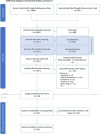Feasibility of mitigation measures for agricultural greenhouse gas emissions in the UK. A systematic review
- PMID: 38161803
- PMCID: PMC10754757
- DOI: 10.1007/s13593-023-00938-0
Feasibility of mitigation measures for agricultural greenhouse gas emissions in the UK. A systematic review
Abstract
The UK Government has set an ambitious target of achieving a national "net-zero" greenhouse gas economy by 2050. Agriculture is arguably placed at the heart of achieving net zero, as it plays a unique role as both a producer of GHG emissions and a sector that has the capacity via land use to capture carbon (C) when managed appropriately, thus reducing the concentration of carbon dioxide (CO2) in the atmosphere. Agriculture's importance, particularly in a UK-specific perspective, which is also applicable to many other temperate climate nations globally, is that the majority of land use nationwide is allocated to farming. Here, we present a systematic review based on peer-reviewed literature and relevant "grey" reports to address the question "how can the agricultural sector in the UK reduce, or offset, its direct agricultural emissions at the farm level?" We considered the implications of mitigation measures in terms of food security and import reliance, energy, environmental degradation, and value for money. We identified 52 relevant studies covering major foods produced and consumed in the UK. Our findings indicate that many mitigation measures can indeed contribute to net zero through GHG emissions reduction, offsetting, and bioenergy production, pending their uptake by farmers. While the environmental impacts of mitigation measures were covered well within the reviewed literature, corresponding implications regarding energy, food security, and farmer attitudes towards adoption received scant attention. We also provide an open-access, informative, and comprehensive dataset for agri-environment stakeholders and policymakers to identify the most promising mitigation measures. This research is of critical value to researchers, land managers, and policymakers as an interim guideline resource while more quantitative evidence becomes available through the ongoing lab-, field-, and farm-scale trials which will improve the reliability of agricultural sustainability modelling in the future.
Supplementary information: The online version contains supplementary material available at 10.1007/s13593-023-00938-0.
Keywords: Arable farming; Carbon footprint; Farming interventions; Livestock systems; Mixed farming; Net zero.
© The Author(s) 2023.
Conflict of interest statement
Competing interestsThe authors declare no competing interests.
Figures



Similar articles
-
Willingness to adopt green house gas mitigation measures: Agricultural land managers in the United Kingdom.PLoS One. 2024 Jul 8;19(7):e0306443. doi: 10.1371/journal.pone.0306443. eCollection 2024. PLoS One. 2024. PMID: 38976702 Free PMC article.
-
The 2023 Latin America report of the Lancet Countdown on health and climate change: the imperative for health-centred climate-resilient development.Lancet Reg Health Am. 2024 Apr 23;33:100746. doi: 10.1016/j.lana.2024.100746. eCollection 2024 May. Lancet Reg Health Am. 2024. PMID: 38800647 Free PMC article. Review.
-
Net greenhouse gas balance in U.S. croplands: How can soils be part of the climate solution?Glob Chang Biol. 2024 Jan;30(1):e17109. doi: 10.1111/gcb.17109. Glob Chang Biol. 2024. PMID: 38273550
-
Quantifying opportunities for greenhouse gas emissions mitigation using big data from smallholder crop and livestock farmers across Bangladesh.Sci Total Environ. 2021 Sep 10;786:147344. doi: 10.1016/j.scitotenv.2021.147344. Epub 2021 Apr 29. Sci Total Environ. 2021. PMID: 33971592
-
The Minderoo-Monaco Commission on Plastics and Human Health.Ann Glob Health. 2023 Mar 21;89(1):23. doi: 10.5334/aogh.4056. eCollection 2023. Ann Glob Health. 2023. PMID: 36969097 Free PMC article. Review.
Cited by
-
Willingness to adopt green house gas mitigation measures: Agricultural land managers in the United Kingdom.PLoS One. 2024 Jul 8;19(7):e0306443. doi: 10.1371/journal.pone.0306443. eCollection 2024. PLoS One. 2024. PMID: 38976702 Free PMC article.
References
-
- Abdul-Salam Y, Hawes C, Roberts D, Young M. The economics of alternative crop production systems in the context of farmer participation in carbon trading markets. Agroecol Sust Food. 2019;43(1):67–91. doi: 10.1080/21683565.2018.1537986. - DOI
-
- ADAS (2019) Mitigation against GHG emissions: agricultural practices review. https://www.gov.wales/mitigation-against-greenhouse-gas-emissions-agricu.... Accessed 07 August 2023
-
- Al Dulayymi J R, Baird M, Bouillon M.E, Duval S, Ramos Morales E, New Bold C J, Preskett D, Radek B, Strawson S, Wehrli C, Lahmann M (2017) New bis esters of ivy sapogenins for ruminants. https://research.bangor.ac.uk/portal/en/researchoutputs/new-bis-esters-o.... Accessed 25 June 2022
-
- Albanito F, Beringer T, Corstanje R, Poulter B, Stephenson A, Zawadzka J, Smith P. Carbon implications of converting cropland to bioenergy crops or forest for climate mitigation: a global assessment. GCB Bioenergy. 2016;8:81–95. doi: 10.1111/gcbb.12242. - DOI
-
- Alskaf K (2018) Conservation agriculture for sustainable land use: the agronomic and environmental impacts of different tillage practices and plant residue retention: farmer uptake of reduced tillage in England. PhD thesis, University of Nottingham. http://eprints.nottingham.ac.uk/51902/. Accessed 25 June 2022
Publication types
Grants and funding
LinkOut - more resources
Full Text Sources
Miscellaneous
